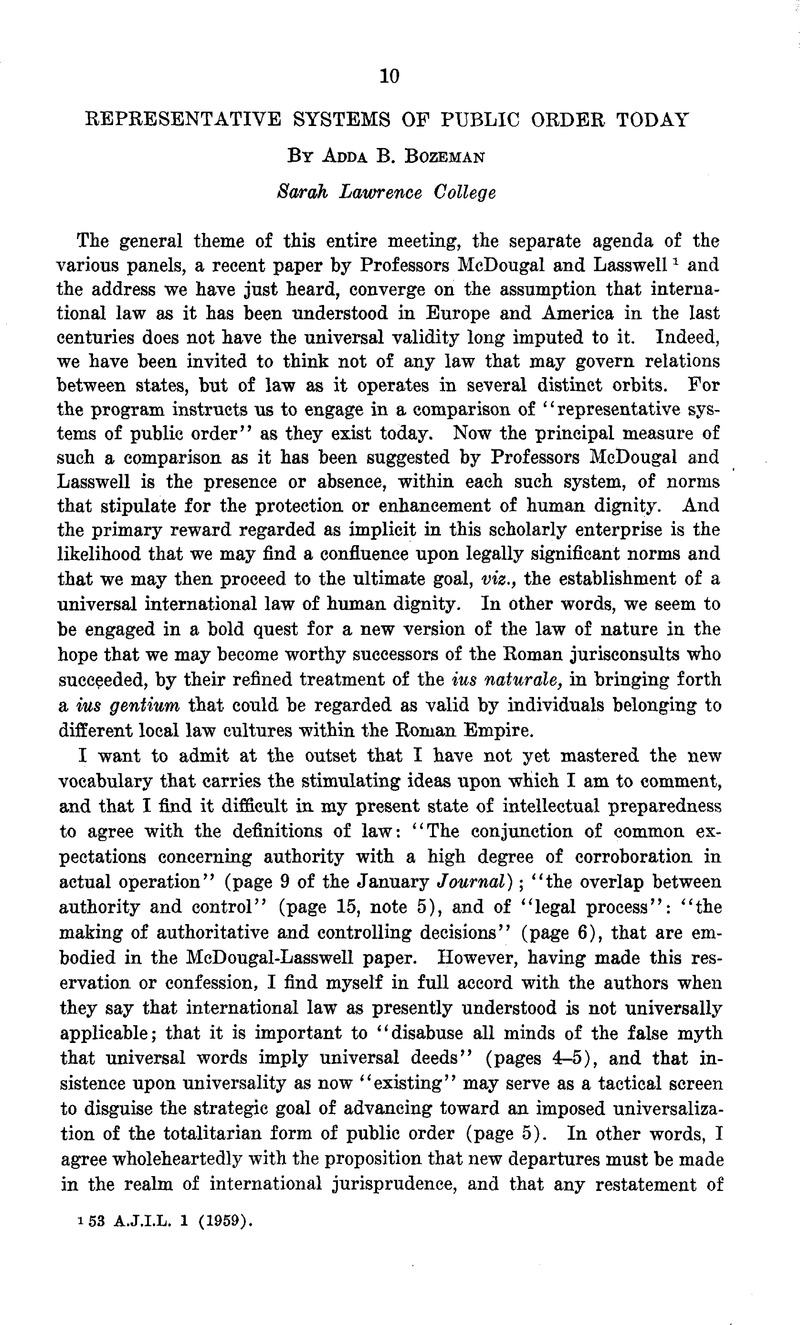No CrossRef data available.
Article contents
Representative Systems of Public Order Today
Published online by Cambridge University Press: 27 February 2017
Abstract

- Type
- First Session
- Information
- Copyright
- Copyright © American Society of International Law 1959
References
1 53 A.J.I.L. 1 (1959).
2 In his attempt to reconstruct the legal life of mankind, Wigmore distinguished sixteen systems. Among these he recognized eight as surviving today: the Anglican, Chinese, Germanic, Hindu, Japanese, Mohammedan, Bomanesque, and Slavic systems. And of these eight he found four in existence as pure systems: the Anglican, Hindu, Mohammedan, and the Romanesque. See A Panorama of the World's Legal Systems (Libr. ed., Washington, D. C, 1936).
3 See Josef L. Kunz for some stimulating comments on these issues in 49 A.J.I.L. 370 ff. (1955).
4 Ibid.
5 Loc. cit. 5.
6 The time at our disposal prevents a consideration of the complex and multifarious systems of order that underlie contemporary law and politics in Africa.
7 “Etudes sur le developpement historique du Droit International dans 1'Europe Orientale,” 11 Hague Academy of International Law, Eeceuil des Cours 345–355 (1926); and “L'apport de Byzance au développement du droit international occidental,” 67 ibid. 237–339 (1939); see also E. W. Johnson, “American Mediaevalists and Today,” Speculum, Vol. 28, No. 4 (October, 1953).
8 The Byzantine protectorate was long accepted also by the republics of Venice, Naples, Gaeta, and Amalfi, and by the Princes of Salerno, Capua and Beneventum.
9 For further references see the works of Ostrogorsky, Vasiliev, Harrison, Runeiman, Diehl, Bury, Dawson, Baynes, Dennet, Nicolson.
10 H. A. R. Gibb, Mohammedanism 89 (London, 1950).
11 Various non-Arab traditions of government asserted themselves in this vacuum of principle; chief among these were the Persian, Byzantine and Turkish traditions which concurred upon the theme of monolithic secular power. See Nizam Al-Mulk (le Vizir), Siasset Nameh, Traité de Gouvernement compost pour le Sultan Melik Chah; trad, par Ch. Schefer, 1894 (Pub. de l'Ecole des Langues Orientales Vivantes, 7). This treatise was written in the eleventh century and used by later generations of Persian and Turkish rulers as the leading text on the Muslim art of government.
12 “Constitutional Organization,” in Khadduri and Liebesny, Law in the Middle East 12 (1955). See also M. Khadduri, “Nature and Sources of Islamic Law,” George Washington Law Review, Vol. 22 (October, 1953).
13 The public will could express itself, before the end of the nineteenth century, through the medium of religious brotherhoods which encompassed all social classes. These brotherhoods succeeded in adjusting the tensions between the “ideal” and the “real“ government. Their disintegration left nothing to counterbalance the power of the state. See Gibb, “Social Eeform: Factor X; The Search for an Islamic Democracy,” in The Atlantic, October, 1956. For further references see the works of Gibb, Guillaume, deGruenebaum, deSantillana, Arberry, Arnold, Schacht and Khadduri.
14 McDougal and Lasswell, loc. cit. 6.
15 See T. E. Holland, Elements of Jurisprudence 52–54 (Oxford, 1880, new ed., 1928).
16 “Indian Doctrines of Politics,” First Annual Lecture at the Harold Laski Institute of Political Science, pp. 2, 3.
17 Bombay-Calcutta (1954), p. 29.
18 K. V. Eangaswami Aiyangar, Considerations on Some Aspects of Ancient Indian Polity 34 (Madras, 1916).
19 The White Umbrella 8 (Berkeley and Los Angeles, 1958).
20 A. L. Basham, The Wonder That Was India 88 (London, 1954).
21 Ibid. 104 ff. See also D. Mackenzie Brown, op. cit. On the relationship of Indian village law to Western concepts of positive law, see Holland, op. cit. 52 ff.
22 Basham, op. cit. 151, to the effect that caste survived all conquests. Even the Muslims, for all their equalitarian faith, formed caste groups. The Syrian Christians of Malabar early divided into sections which took on a caste character. Only in the last fifty years has the caste system shown real signs of breaking down.
23 For a succinct analysis of the personal and social values system in a contemporary orthodox community, see William Stephens Taylor, “Basic Personality in Orthodox Hindu Culture Patterns, ” in 43 Journal of Abnormal and Social Psychology 3 ff. (1948).
24 Basham, op. cit. 112; Mackenzie Brown, op. cit. 15.
25 Basham, op. cit. 137.
26 Philosophies of India 87 f. (New York, 1951).
27 Ibid. 104.
28 S. V. Viswanatha, International Law in Ancient India 90 (London, 1925).
29 Zimmer, op. cit. 114–115.
30 Basham, op. cit. 125; also Zimmer, op. cit. 120–122, on seven different ways of approaching neighboring states. Asoka was the only ancient king who broke with the Indian tradition of aggressiveness in international affairs.
31 Beni Prasad, Theory of Government in Ancient India—Post Vedic 362 (Allahabad, 1927).
32 Le Droit Chinois 3 (Peiping, 1936); see also p. 359.
33 See Joseph Needham, Science and Civilization in China, Vol. I I , pp. 519 ff., 582. Cf. J. N. Frank, Courts on Trial: Myth and Reality in American Justice, p. 378 (1949), to the effect that ancient Greek, as opposed to ancient Roman, law shared to a considerable extent the characteristic Indian and Chinese preference for equity and arbitration ai opposed to abstract formulae.
34 Needham, op. cit., Vol. II, pp. 526–528.
35 Op. cit. 17.
36 Needham, op. cit., Vol. II, p. 529.
37 Cf. with similar rights recognized in the Islamic system and in the medieval Western European system, in accordance with which commands of princes that were contrary to natural law were not binding on their subjects and could therefore be resisted lawfully. See Needham, op. cit., Vol. I I , p. 538.
38 M. F. Nelson, Korea and the Old Order in Eastern Asia 190 (1945); see also ibid. 91 and 102 ff. for a discussion of Western misinterpretations of these relationships.




